Can you imagine our downtown with unattractive and vacant storefronts, empty upper floors, and few year-round restaurants and businesses? Can you imagine the beautiful building that is home to Universal Preservation Hall and its lively performances not existing? Can you imagine Union Avenue without its wonderfully preserved mansions?
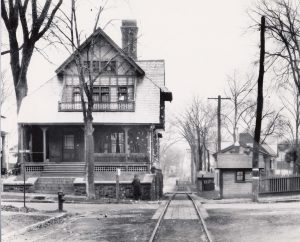
117 Grand Ave, 1927
Many of those who have recently moved here may find it hard to believe that there was a time when our downtown was suffering and that there were buildings such as Universal Preservation Hall and mansions along Union Avenue that were threatened by demolition. The residents who have lived here longer than 40 years certainly do remember a time when Saratoga Springs wasn’t as attractive and vibrant as it is today. The Saratoga Springs Preservation Foundation’s efforts to preserve our community’s historic downtown and residential neighborhoods have played a critical role in the success that Saratoga Springs sees today.
On April 7, 1977 the Saratoga Springs Preservation Foundation was incorporated as a non-profit to preserve and protect the historic heritage of Saratoga Springs and leading the charge of the Foundation’s first efforts was a young Julia Stokes, the first Executive Director.
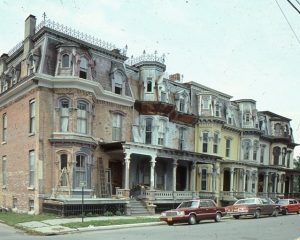
1-5 Clinton Place, 1979
By the 1970s, Saratoga Springs was a historic resort community in decline. Since the 1950s Saratoga Springs had suffered many setbacks. Important local landmarks were lost to a struggling economy, urban renewal, and devastating fires. Those losses combined with the prospects of a hotel being built in historic Congress Park, a highway bypassing downtown through the oldest residential neighborhood – Franklin Square, and the construction of a shopping mall at the edge of town sparked members of the community to act and create the “Plan for Action,” a downtown revitalization plan.
Stokes, who was President of the Junior Civic League, met Beatrice Sweeney, the City Historian, when the League decided to host a fundraiser to preserve the Canfield Casino. Sweeney, who was in the process of nominating the Franklin Square Historic District to the National Register of Historic Places, hoped to enlist Stokes to become involved in preservation, a relatively new concept for cities across the country. Sweeney must have been persuasive as Stokes, who had a BA in Government and Biology from Elmira College, started reading articles on historic preservation. Upon Stokes learning that grant funds may be available to preserve buildings such as the Casino she approached Mayor Raymond Watkin. Shortly thereafter, he formed a Historic Preservation Committee and established the Office of Community Development. Stokes, who had been taught by her mother the importance of civic responsibility and volunteering, served on the committee. She was later hired as a consultant of the Office of Community Development to inventory the city’s historic buildings.
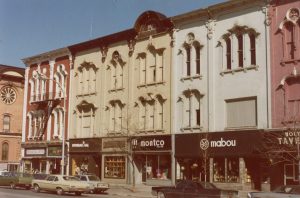
Built by Seymour Ainsworth in 1871, this mixed-use building was predominately vacant a century later.
With $15,000 allocated from the City budget, the Foundation was established. The ten original board members – Newman “Pete” Wait Jr., Neil Collins, Bernard Donovan, Mark Straus, Donald Lee, Mildred Rockwell, Jacob Feynman, Gladys Ehrgott, Beatrice Sweeney, and LeRoy Walbridge – all owned historic buildings and were both financially and emotionally invested in the community’s future. Stokes was a perfect fit for the job and was hired as the first Executive Director. Walbridge donated space on the second floor of his building (now home to Cantina and Lifestyles) for the Foundation’s first office.Preserving many of the downtown historic buildings that were in disrepair and/or vacant was identified as being critical to the success of the Plan for Action. A grant program was to be established to provide funding to building owners to rehabilitate the historic exteriors and make the buildings code compliant. It was determined that the program should be managed independently of city government and politics and that an organization should be formed to be an advocate for the historic buildings.
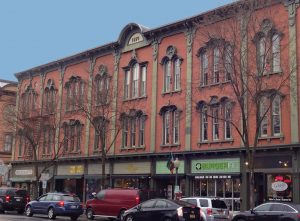
Ainsworth Building today, the foundation’s early initiatives insured the proper restoration of the city’s historical buildings.
Immediately the Foundation worked in partnership with the Office of Community Development, which provided the initial $450,000 for funding. Historic building owners could receive up to $25,000 (a large sum at the time) to make their buildings code compliant and to renovate/restore the exteriors in exchange for a 25 year preservation easement – requiring any exterior alterations to have approval from the Foundation. In total, 26 downtown buildings benefitted by this program. The results of that program can still be seen today.
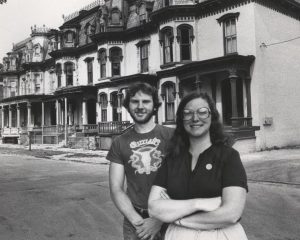
Julie Stokes and Colleague in front of 1-5 Clinton Place – one of the foundation’s first preservation projects.
With Stokes’ leadership, the Foundation went on to inventory and list neighborhoods on the National Register of Historic Places, advocate for a stronger local historic preservation ordinance, plant trees on Broadway, restore the row house at 5 Clinton Place, and preserve the nearly 80 historic buildings left vacant after Skidmore College moved its campus to North Broadway.
“Julie was never afraid to put her work clothes on and get her hands dirty to get the job done no matter how difficult it was – from planting trees to working on 5 Clinton Place,” said Linda Toohey, long-time friend and publisher of “The Saratogian” at the time. “You have to remember that preservation was new at that time, people had no understanding of what it was, unlike today. Julie tirelessly worked to collaborate with everyone to change the face of our community,” said Toohey.
As the current Executive Director of the Foundation, I thank Julia Stokes for paving the way for the Foundation to preserve Saratoga Springs. I, at times, find it challenging, so I can’t imagine how challenging it must have been to be the first. I’m proud to follow in your footsteps.
Samantha Bosshart is Executive Director of the Saratoga Springs Preservation Foundation. Founded in 1977, the Saratoga Springs Preservation Foundation is a private, not-for-profit organization that promotes preservation and enhancement of the architectural, cultural and landscaped heritage of Saratoga Springs. To learn more or to become a member, please visit www.saratogapreservation.org.
